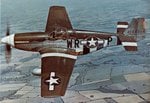Reading one of the threads got me thinking... One often hears how allied planes where often marked/painted to help with identification. I've hears several stories about planes shot down by mistake, typhoons mistaken for focke wulfes, mustangs for me 109's....
Anyone have any documentation on the Axis doing the same?
I know often other Axis nations did the yellow wing tips, noses to stand out.
and there was reference in another thread about a battle between 109's and 190's .
Anyone have any documentation on the Axis doing the same?
I know often other Axis nations did the yellow wing tips, noses to stand out.
and there was reference in another thread about a battle between 109's and 190's .

![354 WRF and WRF_Lenfest-Mar44 [lenfest].JPG](/forum/data/attachments/69/69446-be371109b98d684b5cb07f09b4e2bc79.jpg)
![354 WRC_Kinnard_42-75275_8mar1944 [moseley].jpg](/forum/data/attachments/69/69447-6ee2cd21fccd334a594fbe25d0c83d17.jpg)
